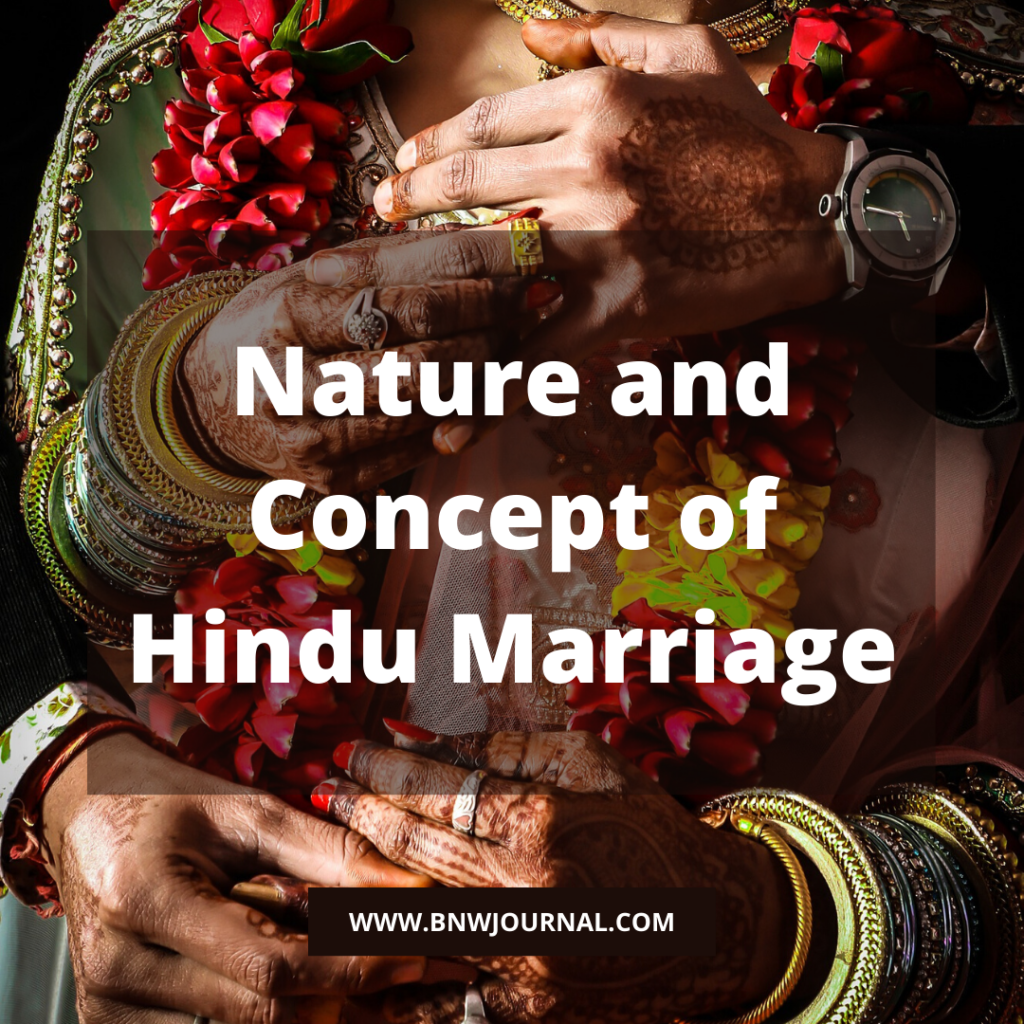![]()
Introduction
“Marriage among the Hindus is considered divine in nature. It is a religio bond and not a contractual union. A sacramental union implies that it is a permanent bond that does not end in this world or after the death of either partner but it continues even after death, in the next life”[1].

However, marriage is considerably a contractual bond between two parties according to the Hindu Marriage Act, 1955. Marriage is a basic social institution. In Hinduism marriage is seemingly one the most important and greatest of all other social institutions. “The term marriage has been derived from merry which means happiness and its equivalent in Hindustani is ‘Shad’, a Persian word”[2]. “Marriage can be defined as the legal union of a man and a woman as husband and wife”[3]. It is a bond two parties share that no one can take away from them; unless and until divorce takes place.
Marriage as a concept has evolved according to time, place, people, and culture. In the early times if a husband dies, the woman has no allowance to marry again. Instead she had to perform sati. There is no age bar for marriage, and hence many people married during their childhood. There was involvement of the dowry system during marriage. Which in turn made the parents of a girl child feel that, a woman is a burden to their family. To stop such practices, there was passing and implementing of the Hindu Marriage Act in the year 1955.
Nature of marriage under Hindu Law
Marriage between two parties is to establish a relationship between them as husband and wife. According to Hindu law, the nature of marriage is considered a sacred tie that cannot be broken ever. This allows a man and a woman to perform religious and spiritual duties.
According to Section-2 of Hindu Marriage Act, 1955 “any person who is a Hindu by birth or who has changed his/her religion to either any of its forms such as Virashaiva, a Lingayat or a follower of the Brahmo, Prarthana or Arya Samaj; any person who is a Buddhist, Jain, or Sikh also comes under this act”[4]. This act is also applicable to every person outside the territory or are governed under the Hindu Law; except for those who are Muslim, Christian, Parsi, or Jew.
A person who is born in a Hindu family or has a Hindu father or mother, he is seemingly Hindu from birth. When a person is born in any community apart from Muslim, Christian, Jews; he is also considerably a Hindu. It is not a matter of fact, whether a child is legitimate or illegitimate if either of his parents is Hindu then a child out of such wedlock will be deemed as Hindu[5]. Every Hindu is governed under the Hindu Marriage Act, 1955.
There are various forms of marriage under the Hindu law namely:
- Brahma Marriage
In this form of marriage, the groom gets the bride as a gift. This is also known as an arranged marriage.
- Gandharva Marriage
This form of marriage is also known as love marriage; where the marriage takes place with the consent of both the groom and the bride. It is prevalent in the modernized part of society, where both parties get equal opportunities to select each other.
- Asura Marriage
In the case of asura marriage, the father sells the bride and forces her for marriage. This form of marriage is still prevalent as most of the families still practice dowry.
Conditions for valid of a Hindu Marriage
The conditions mentioned under section-5 of the Hindu Marriage Act, 1955[6] are the valid requisites to perform a marriage under the Hindu Law. If there is no implementation of the conditions under the act then such a marriage is not considerably a valid marriage.
- Monogamy:
According to the Section 5(i) of the Hindu Marriage act, 1955, there should not be a living spouse of a person at the time of marriage. According to Hindu Law, a spouse has no allowance for more than one wife or more than one husband. It is a punishable offense under section-494 of the Indian Penal Code, 1955. In the case of Adhav v Adhav[7], “the Supreme Court has held that a marriage with a person who has a living spouse is null and void and it cannot be treated as voidable under section-12 of the Act”[8].
- Bigamy:
Bigamy in simple terms, means having two wives at the same time. Hindu Law strictly prohibits it and deems it as illegal. Without performing divorce with the first wife or husband, marriage cannot take place, and if such a marriage takes place it would be considered illegal. It is regardably a punishable offense under Section 494 and 495 of the Indian Penal Code, 1860; for performing the second marriage despite having a living husband or wife. “In Smt. Sushma Choure v Hetendra Kumar Borkar[9], the court has held that the second marriage performed during the subsistence of first marriage is strictly void”[10].
- Conditions regarding mental health or capacity:
According to Section-5 (ii) (a), (b), (c) of the Hindu Marriage Act, 1955 if a person is of unsound mind at the time of marriage, or if there is any condition in relation to mental health or capacity of the person, such a marriage is considerably void. For a valid marriage to take place a person shall be capable to give consent for such an act.
- Condition for marriageable age:
According to Hindu Marriage Act, 1955 it is obligatory that the bride must have completed the age of eighteen years and the groom must have completed the age of twenty-one at the time of marriage to hold the marriage valid. If the parties fail to fulfill the condition then the marriage is as illegal and void.
- Sapinda relationship:
Certain relationships are under prohibition from the law, to carry out the act of marriage. Such relationships fall under the concept of Sapinda relationships. Sapinda relationship is the chain of all the relationship from the side of the maternal or paternal side in the family. Such marriage is a prohibited relationship until three generations from the girl’s side and five generations from the boy side. However, if there is allowance of such marriage according to the custom the families follow then the marriage is not considerably illegal nor declarable as void.
Other Conditions
In addition to Section 5, of the Hindu Marriage Act, 1955, according to Section 7 of the said act, for solemnization of a Hindu Marriage, its performance shall take place with all the ceremonies and rituals via both the parties getting married; which includes saptapadi, where the bride and groom take seven rounds around the fire and only after the completion of this the marriage is complete and binding.
According to section-8 of the said Act, the registration of marriage shall take place according to the requisites mention under the said section of the Hindu Marriage Act, 1955. If the marriage taking place contravenes any of the provisions of the act, the marriage is void according to Section 11. It is not enforceable.
References:
[1]Nature of Hindu Marriage : Contractor Sacrament of Marriage, , Toppr-guides (2019), https://www.toppr.com/guides/legal-aptitude/family-law-II/nature-of-marriage-under-hindu-law/ (last visited May 1, 2020).
[2] Mayank Shekhar, Concept and forms of marriage, Legal Bites – Law And Beyond (2017), https://www.legalbites.in/concept-forms-marriage/ (last visited May 1, 2020).
[3] Hindu Marriage as a Religious Sacrament, , Your Article Library (2015), http://www.yourarticlelibrary.com/marriage/hindu-marriage-as-a-religious-sacrament/47463 (last visited Apr 30, 2020).
[4] Section-2, Hindu Marriage Act, 1955
[5] Hindu Marriage Act, 1955
[6] Section-5, Hindu Marriage Act, 1955
[7] 1988 SC 644
[8] Ibid, 6
[9] AIR 2010 Chattisgarh 30(DB)
[10] Ibid, 8



0 Comments